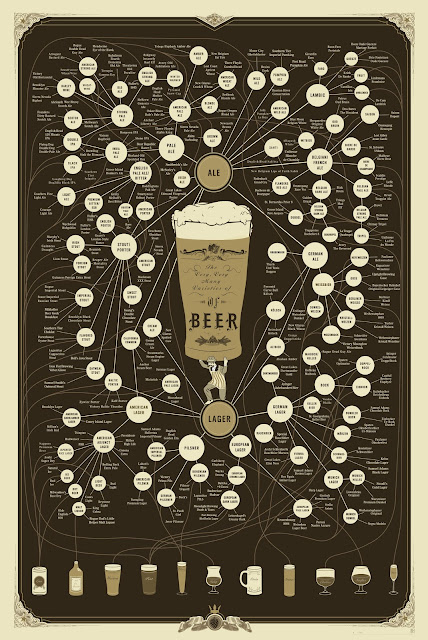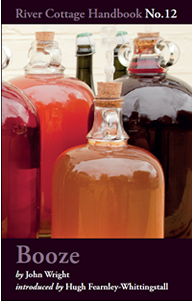British Beer Styles
 |
Thanks for use of poster to:
|
British beer is incredibly diverse; no
wonder as there’s now over 1,000 breweries in the UK. From biscuity
and citrus golden ales to peppery hop characterful bitters and dark
roasted malt liquorice stouts. Trying to navigate the wide choice
available, to find what floats your taste buds can be tough (and
enjoyable!). It’s a bit like walking into a record store looking
for a new album to purchase, in that you don’t know what you’re
looking for, but you know which genre you like to start digging
through the racks at the right point. In this way beer styles are a
helpful grouping putting similar beers together in terms of all of
these elements - yeast type, fermentation, ingredients and brewing
techniques. Camra
list nine British beer categories, these are: Mild, Bitter, Golden
Ales, Pale Ales and IPAs, Porter and Stouts, Barley Wine, Old Ale,
Scottish Beers and Light Bitters.
To make it even simpler colour can be a
good indication of the qualities a beer possesses and can therefore
point you in the direction of beers you’ll relish supping. Cyclops
beer indicators look to three groupings – golden, amber and dark
and you may have come across their one eyed symbol on the back of
your beer bottle. Golden covers light, zesty and crisp beers such as
blonde beers; amber covers bitters, pale ales and India pale ales
(IPAs) which are often malty toffee flavours with spicy floral aromas
coming from the hops used in these styles and dark describes stouts
and porters with their roasted coffee and chocolate bitter tangs.
With the growth in British brewing you
find styles overlapping as brewers experiment and new beer styles
created, at the end of the day it’s all about good beer. The
Society of Independent Brewers (SIBA)
conference is coming to Sheffield in March and there’ll be a
boundless number of beers to explore, up to 700, at one of the
largest UK beer gatherings (up to 5,000 people are expected to
attend).
On a recent beer sampling mission to
speciality off licence The
Dram Shop in Crookes I picked up a small selection of
beers to help illustrate a few of the styles mentioned:
Kelham Island Brewery
‘Riders of the Storm’ 4.5% abv (pale ale):
A Sheffield brewing
legend in its own right re-establishing the city’s brewing
credentials in 1990 in the Beer Garden of the Fat Cat in Alma Street
by university lecturer turned pub and brewery owner Dave Wickett.
Dave’s son Edward continues the first-rate work as sadly his father
passed away in May 2012. Dave was responsible for so many beery
good things, his legacy really does
live on – he opened sports bar Champs,
invested in Thornbridge brewery and helped open the Wellbeck
Abbey Brewery as part of the School
of Artisan food.
Tasting notes: Pours
amber, on the darker side of pale ale. Caramel and citrus aromas
followed on the taste with crisp dried fruits and a malty bitter
finish. Hops used include British Fuggles and Goldings, supplemented
with hops from over the Atlantic.
The Kernel brewery opened only a few
years ago in Bermondsey, London by Evin
O'Riordain.
He was awarded British
Guild of Beer Writers Brewer of the
Year in 2011 and the Kernel beers often dominate the top beers UK
lists on craft beer enthusiast sites such as Ratebeer.
Evin has a passion for beer history and this Imperial Brown
Stout was developed from an 1856 recipe.
Tasting notes: A thick dark stout pours from the bottle leaving a thin head. Intense liquorice, chocolate and roasted aromas follow with treacle and coffee tinged flavours. It has a dense mouth-feel with soft carbonation. Overall the Kernel delivers a sublime Imperial stout with intense powerful flavours.
Bristol
Beer Factory - ‘Seven’ 4.5% abv (best
bitter):
Bristol’s Beer Factory has been
brewing since 2005 and has played a key part in the regeneration of
their local community of Southville and Ashton. Every time I visit
Bristol I always make a trip to the Tobacco
Factory which sits opposite and is one of the principal
outlets for their malty goodness. 2001 was another big year for this
outfit winning the BBC Food and Farming Awards for ‘Drinks Producer
of the Year’ and their ‘Southville Hop’ beer winning gold at
SIBA’s Southwest competition.
Tasting notes: Seven is a
traditional English best bitter. Pouring with an amber colour and
nicely carbonated. Maris Otter malts provide toffee malt flavours,
good crisp smooth bitter drink using traditional English Fuggles
hops.
The
Durham Brewery ‘Bombay 106’ 7% abv (India pale
ale):
‘Bombay 106’ is another historical
recipe in the selection, this time from North East brewery, Durham,
re-discovering an IPA from a 19th century recipe. Bombay 106 was the
name of the brigade of Durham Light Infantry out in India the same
time this beer style was popular.
Tasting notes: Lovely old
fashioned IPA pouring a very pale golden colour and highly carbonated
in the glass. Floral herbal aromas packing a Seville orange punch and
tasting spicy with a powerful hit from the quantity of English
Goldings hops used in the brew.
Thornbridge
‘Thorny Goat’ 6% abv (porter):
This Bakewell based
brewer need little introduction in Sheffield due to their ever
growing pub operations from The Greystones to the Cross Scythes to
Dada and more; you can always rely on their venues to provide superb
beer and food. Their beer always appears in UK and World
Beer Awards lists – most recently
their Black IPA ‘Raven’ winning the coveted first prize in that
beer style category in 2012.
Tasting notes: Pours pitch black
in the glass with a luscious appealing slickness. A collaborative
beer with Mountain
Goat Beer in Australia this
is highly hopped black ale. The mocha element adds vigour to the
existing roasted coffee aromas tasting vanilla and fudge like with a
long glorious aftertaste. English Malt Bill and all Anzac hops were
used in this cross-equatorial collaboration.









Comments